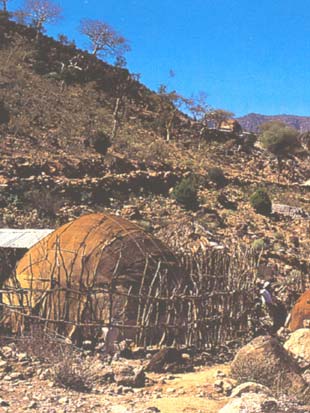 | Somalian Traditions | ||
|---|---|---|---|
| Khat Tradition | The Somali Nomads House | Female Genital Mutilation | |
Aqal Somali = Somali House
Unlike other African nomads who build their huts on-site and abandon them when they move, Somali nomads transport their homes on the backs of camels, like Mongolian nomads, during their journeys. These houses are prepared once and for all by the nomadic women, who then maintain and renew them for the rest of their lives.
|
Description of Nomadic Houses The nomadic house is a circular room with another small room inside, around the bed. To obtain beams, women use very long and sturdy branches from certain trees (called galool, qudhac... very tall and thorny trees) known for their strength. These branches must have two branches at a certain height to serve as elbows, like a two-pronged fork. They are then lightly burned to make them more flexible. While still hot, the women peel them and place them on the ground with large stones on top to stand them up as straight as possible, leaving them for one or two weeks to dry completely. These beams are called udbo. |
 |
Somali Nomad Hut
For the framework, they use another type of wood, taking only thin and young sticks, which they, in turn, burn, peel, and bind with a moistened and cut animal skin to obtain strings. These are then left to dry, taking the shape of a crescent moon. Nomads call these frameworks dhigo. To avoid gaps between the frameworks, nomadic women use other small sticks prepared exactly like the previous ones, except they obtain them by digging at the base of certain trees, taking their young roots, which, when dried, remain flexible. These are called lool.
Covering the House
During the rainy season, women collect herbs known for their resilience, growing in high mountains or on steep rocks inaccessible to grazing animals. Some are known as saxati or cawsalool, while others, called gargoor, grow in plains but are so resilient that animals do not eat them. Once the herbs are dried, sorted, and rid of thorns for some, the women weave them with previously prepared strings made from bark fibres, dyed in various colors to create geometric patterns, much like a carpet. These pieces have different names, and each is intended for a specific part of the house: harar, an undecorated piece, is meant to cover the roof and sides; alool, a very resilient piece made of small young wood bound with animal skin strings, is placed on the windward side. Kebed, made of bark fibre and decorated with various figurines on one side, is exclusively for the interior as it is warm, soft, and attractive.
In the middle of the room, a bed is constructed, which, once assembled, resembles a Western-style bed frame, and over which nomads stretch an animal skin before letting it dry. Then, they build a small room around the bed and hang a piece of the famous kebed at the bed's door to separate it from the rest of the room. All utensils are arranged between the main room and the bed, except for precious items that are attached around the bed.
Thus, each girl leaves on the day of her marriage with a complete and entirely new house prepared by her mother, except for the bed, which she will prepare herself. She will then maintain her house as her mother did and prepare her daughter's house in turn.
